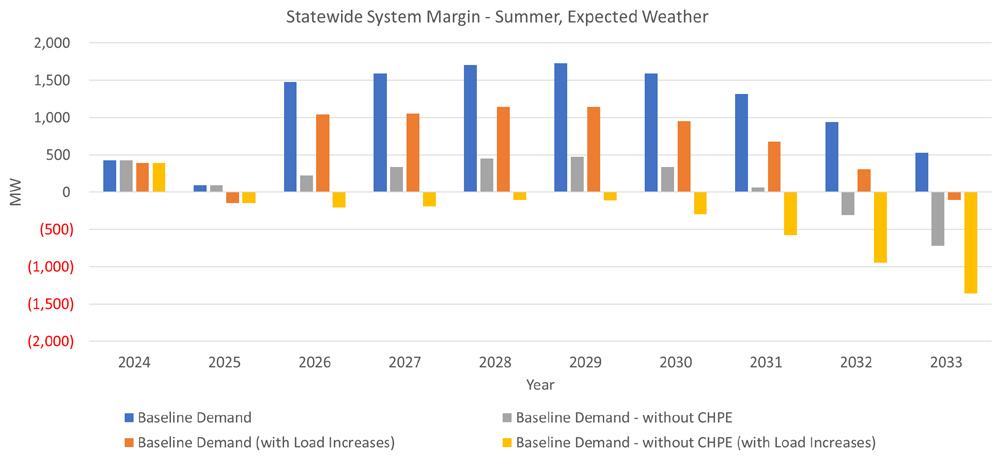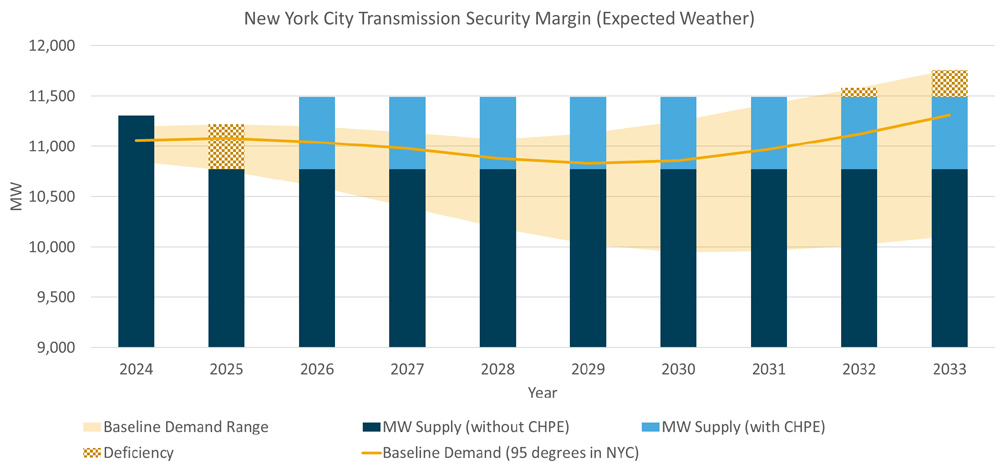New York City faces a reliability margin shortfall of up to 446 MW in 2025 due to plant retirements and the delayed completion of the Champlain Hudson Power Express, NYISO said Friday in its Short-Term Assessment of Reliability (STAR) for the second quarter.
The STAR report for the five-year period ending April 15, 2028, forecasts rising loads due to increased electrification of transportation and buildings, continued economic growth following the pandemic and the expected retirement of generators under the state Department of Environmental Conservation’s “peaker rule,” which took effect in May.
NYISO CEO Rich Dewey told the New York State Reliability Council Executive Committee Friday that the ISO is projected to fall short of its transmission security margin, a measure of the power system’s ability to withstand disturbances such as short circuits or unanticipated loss of a generator or transmission line, while continuing to supply and deliver electricity. Dewey said the CHPE, which will deliver hydroelectric power to New York from Quebec, “would solve this problem, but its in-service date slipped to the spring of 2026.”
DEC’s peaker rule, approved in 2019, is intended to limit nitrogen oxides (NOx) emissions from simple-cycle combustion turbines.
As of May, 1,027 MW of affected peakers have deactivated or have limited capacity, while an additional 590 MW of Zone J peakers are expected to be impacted by the DEC’s rule beginning May 1, 2025.
Under baseline weather conditions (95 degrees Fahrenheit) in 2025, the ISO said the higher bound of expected demand will result in a deficiency of 446 MW over nine hours. The deficiency would be “significantly greater” if the city experiences a heat wave (98 F) or an extreme heatwave (102 F), the ISO said.
If the CHPE experiences further delays, more fossil fuel plants become unavailable, energy demands exceed forecasts or significant extreme weather events elevate loads, reliability margins could “continue to be deficient for the 10-year planning horizon,” the report said.
Because the DEC anticipated that peakers may need to remain online longer than required, it authorized NYISO to order a two-year extension through 2027 and an additional two-year extension through 2029, should these plants be needed for reliability.
Both Dewey and the report, however, emphasized that keeping the peakers online is a “sub-optimal solution” and would be used only after NYISO exhausts all other possibilities.
Dewey said NYISO will work with transmission owner Consolidated Edison to develop solutions and will evaluate proposed solutions that will be solicited from developers throughout the summer. NYISO will review submissions, which could include generation and demand response, in the fall and decide on the best way forward during November.
Dewey confirmed that NYISO likely would return to the July 25 Electric System Planning Working Group with a more comprehensive statement regarding the near-term reliability need.
Con Ed said it is reviewing the STAR report and “remains committed to providing reliable, safe service for to customers, and supporting the state’s important clean energy transition.”
The report notes that although CHPE will help reliability in the summer, “the facility is not expected to provide any capacity in the winter.”
Statewide Shortages?
The Q2 STAR also found that New York could face a statewide deficiency of up to 145 MW by 2025, which could remain through 2033, because of the assumed unavailability of power plants complying with the peaker rule.
The ISO said additional large load interconnection projects in western and central New York are expected to increase 2025 demand by 764 MW. “If CHPE does not begin operation, the statewide system margin is projected to be deficient for all years 2025 through 2033 when considering the additional large loads,” according to the report.
During the NYSRC EC meeting, attendees worried about the Q2 STAR’s findings and questioned how projected deficiencies might impact NYISO’s future planning considerations.
Two attendees inquired about the peaker rule and whether it was simply easier or more economically viable to allow these emissions-producing plants to stay online.
Zach Smith, NYISO vice president of system and resource planning, again confirmed that extending the peaker rule was a “last resort,” and responded that this option would be selected only after “NYISO considers the backstop solution Con Ed is required to provide and reviews all solicited proposals.”
Mark Younger, president of Hudson Energy Economics, asked if NYISO has been providing adequate market demand signals to its resources and would reconsider current price signals to be based on more long-term forecasts.
Dewey responded, “I think that that will be the subject of a lot of discussion over the next year and as we undergo the next demand curve reset.” The DCR occurs every four years and updates the assumptions that determine the installed capacity demand curves. (See FERC Accepts NYISO’s 17-Year Amortization Period Proposal.)
Roger Clayton, chair of the NYSRC’s Reliability Rules Subcommittee, asked whether NYISO would give greater consideration to nuclear resources.
Dewey responded that the Climate Leadership and Community Protection Act’s scoping plan included a notice on how nuclear energy should be investigated. “Nuclear development could be solution for these challenges … but I am curious to see if [nuclear] gets any additional traction in discussions at the … Public Service Commission,” he added. The PSC recently ordered staff to identify technologies, like nuclear or hydrogen, which could keep New York in CLCPA compliance. (See NY Renewable Portfolio May Come up Short on Getting to Net Zero.)
Wes Yeomans, an NYSRC consultant, asked about the STAR’s statewide findings and if that future reliable marginal deficiency requires any immediate action by the ISO.
Smith answered that “the statewide margin is for informational purposes at this point and there is no action to take at this time,” adding, “we’re providing this as information of basically a need possibly to come.”
Gavin Donohue, CEO of the Independent Power Producers of New York, released a statement on the STAR’s findings, saying, “the pace of play is not keeping up with pace of promises, and this report makes that clear.”
“There have been repeated cautions from the NYISO regarding grid reliability, and this report highlights the reality that generator retirement cannot outpace the addition of new generation with the attributes needed by the NYISO to maintain reliability,” he added.



